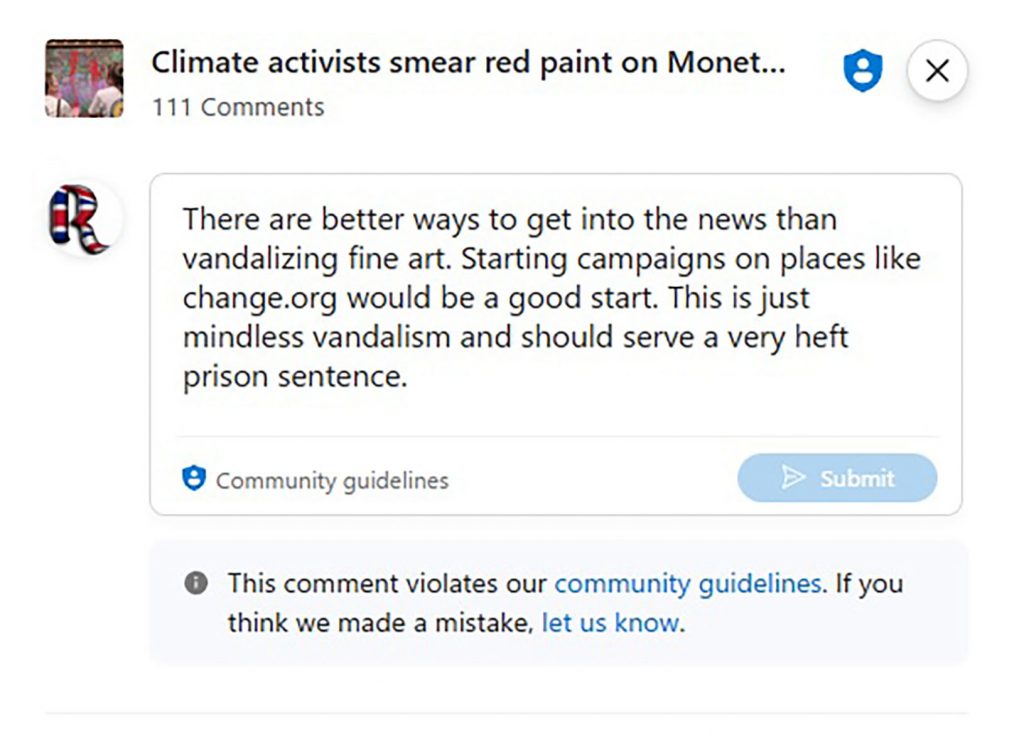
Climate activists vandalize and smear red paint on Monet’s artwork at the Stockholm museum
Climate activists smear red paint on Monet artwork at Stockholm museum (msn.com)
This is how it’s done when organizations try to stonewall you.
When organizations try to stonewall you, you turn to your own uncensored platforms. What did I say that violate community guidelines?
The Incident
In a shocking act of protest, climate activists targeted an iconic piece of art at a museum in Stockholm, smearing red paint on a Monet masterpiece. The incident, which occurred recently, has sparked a heated debate regarding the ethics of using extreme measures in the fight against climate change. While activism plays a crucial role in raising awareness about environmental issues, the act of defacing artwork raises important questions about the boundaries of protest and the preservation of cultural heritage.
The affected painting, part of a Claude Monet exhibition at the museum, has long been revered as a masterpiece of Impressionism. Visitors were left stunned when they discovered the artwork defaced with red paint, obscuring the serene landscape that Monet had carefully crafted. The vandals left a message alongside the defaced painting, highlighting their intention to draw attention to the urgent need for action on climate change.
Activism and Climate Change
The urgency of addressing climate change cannot be overstated. Scientists and experts around the world have repeatedly warned about the devastating consequences of environmental degradation. Climate activists have played a vital role in raising awareness about these issues, demanding policy changes, and pushing for collective action to mitigate the effects of climate change. Peaceful protests, strikes, and public demonstrations have been effective tools in mobilizing public support and driving political will.
The Ethical Dilemma
While activism is an essential part of any democratic society, it must be carried out within the bounds of legality and ethical principles. The act of defacing artwork, regardless of the underlying cause, raises serious ethical questions. Art serves as a bridge between cultures and generations, offering insights into history, emotions, and human expression. It holds significant cultural value and must be preserved for future generations to appreciate and learn from.
Preserving Cultural Heritage
Museums play a critical role in preserving our cultural heritage, providing a space for art to be admired, studied, and enjoyed by the public. These institutions have dedicated considerable resources to safeguarding and conserving artworks, ensuring their longevity and accessibility. By defacing a piece of art, activists not only violate the sanctity of a cultural object but also undermine the efforts of museums and curators who work tirelessly to preserve these treasures.
Alternative Approaches
While the climate activists’ intentions to draw attention to the urgent need for action are commendable, there are alternative methods to raise awareness and demand change without resorting to destructive acts. Collaborating with museums, organizing exhibitions, or creating a dialogue with artists and curators can be effective ways to engage the public and convey the message of environmental conservation. These approaches facilitate a constructive dialogue between art, culture, and activism, fostering understanding and inspiring change.
Conclusion
The act of smearing red paint on a Monet artwork at a Stockholm museum by climate activists has ignited a fierce debate regarding the boundaries of protest and the preservation of cultural heritage. Climate change is an urgent issue that demands immediate action, and activism has proven instrumental in raising awareness and driving change. However, destructive acts like defacing artwork undermine the message and overshadow the broader cause. Collaboration, dialogue, and peaceful demonstrations provide more effective avenues for climate activists to engage the public, generate awareness, and foster positive change without compromising our shared cultural heritage. It is crucial that we find the balance between activism and preserving our collective history, ensuring a sustainable future for both our planet and our cultural legacy.
I believe there are better ways to get your point across and vandalism is not one of them.
#climatechange #climatechangeprotestors #protestors #fineart #museums #monet #monetpainting #vandalism #campaigning
About the author
iRenata -Renata Entrepreneur is a personal brand of Renata M Barnes. Renata has been in business since 1993. Renata is a businesswoman and published author. She primarily focuses on Digital Marketing, Website Creation, SEO, and Domain Brokering.
Renata is a disabled entrepreneur that suffers from OCD and Cerebellar Atrophy. She is an Editor of Disabilityuk.co.uk & CMJUK.com Business journal. She is an advocate for mental health, disability discrimination and human rights.
Renata has a large network of over 12K connections on LinkedIn, https://www.linkedin.com/in/renata-b-48025811/
Renata offers several services for startups and SME’s. Her service includes Website Design & Development, SEO, Marketing, Advertising, Content Writing, and Graphic Design.



Leave a Reply
You must be logged in to post a comment.